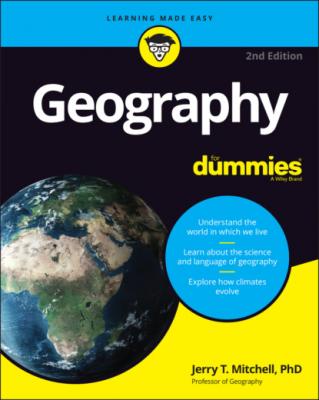Geography For Dummies. Jerry T. Mitchell
Читать онлайн.| Название | Geography For Dummies |
|---|---|
| Автор произведения | Jerry T. Mitchell |
| Жанр | География |
| Серия | |
| Издательство | География |
| Год выпуска | 0 |
| isbn | 9781119867142 |
Maps of the world are among the most basic aids to geographic learning. Many people take it for granted that they are truthful. But in reality, all flat maps of the world lie — they simply cannot help it. If you’re new to thinking geographically, it is important that you appreciate that simple fact and understand the ways in which maps distort their portraits of your Earthly home. This chapter shows just how flat maps lie.
Seeing the Light: Map Projections
Accordingly, this chapter is about mapmaking with emphasis on the distortions that are inherent in flat maps of the world. But first, some basic vocabulary is in order. A map is a representation of all or part of Earth’s surface. Cartography is the field of mapmaking, and a cartographer is a person who makes maps. Way back when, cartography was pure freehand, and I do mean way back. The oldest known map is a 5,000-year-old clay tablet that shows physical features of Mesopotamia. Later, cartography became associated with instruments and techniques that most people think of as drafting. Nowadays, most cartography is done using a computer.
(© John Wiley & Sons Inc.)
FIGURE 4-1: Map projection.
The diagram that shows the globe and light bulb is a simple model that most people find helpful in visualizing how projections are made. In reality, projections aren’t made with a glowing light bulb in the center of a globe. Instead, projections are products of mathematical formulas, trigonometric tables, and things of that ilk. The specifics are pretty tedious; fortunately, trying to explain it all in language that even I can understand is beyond the scope of this book. It will be sufficient for you to appreciate that different projections exist, but none are totally truthful.
Realizing Exactly How Flat Maps Lie
Cartographers have developed literally dozens of different kinds of map projections over the years. Each one contains some degree of misinformation. If you’re like most people you’ve given little or no thought to map projections nor have you suffered from not doing so. Or have you? (For another perspective on why this matters, see the sidebar “Applied Geography: Putting your best projection forward.”)
Understanding the facts about maps can’t help but make you a better-informed person. Maps are a common means of communicating information. They pop up in internet articles, magazines, books, TV programs, and elsewhere. Because mainstream media is in the business of providing factual information, people may understandably assume that the maps they’re looking at are accurate. But maps that lie flat lie, and there’s nothing anybody can do about it — except maybe understand the nature of the distortions and appreciate that flat maps should be interpreted with a certain amount of caution.
Cartographers know projections lie, so their objective is to get as close to reality as possible. But enough of this blabber about maps that lie, it’s time to consider a practical example that involves some honest-to-goodness maps. Or rather, some not-so-honest-to-goodness maps.
Singapore, please. And step on it!
Suppose you live in New York City and are preparing for a trip to Singapore, almost halfway around the world. In planning your trip, you decide to minimize your flying time and also to stop somewhere for a day or two, just to break up your travels. A friend suggests a stopover in Rome, Italy. But another friend tells you to layover in Helsinki, Finland. You have no idea which choice is best, so you decide to find out by plotting the two cities on a map (see Figure 4-2).
(© John Wiley & Sons Inc.)
FIGURE 4-2: New York City to Singapore: Map # 1.
Accepting the principle that a straight line is the shortest distance between two points, the map seems to make your choice pretty clear, doesn’t it? The itinerary to Singapore via Rome is apparently much shorter than the route via Helsinki. As a result, you call your travel agent and make the appropriate bookings.
Upon hearing your travel plans, your second friend is shocked. “You’re not going by way of Helsinki?” To show your friend the wisdom behind your choice, you take out your map and note the obvious: The linear distance from New York to Singapore is shorter via Rome. Whereupon your friend produces a map of her own (see Figure 4-3).
Looking at the map in Figure 4-3, three things are suddenly obvious.
First, the global view in this map is much different than in Figure 4-2.
Second, the results are different, too. In Figure 4-3, going to Singapore via Helsinki appears much shorter than the route via Rome.
Third, one of these maps is lying, but which one?
(© John Wiley & Sons Inc.)
FIGURE 4-3: New York City to Singapore: Map #2.
APPLIED GEOGRAPHY: PUTTING YOUR BEST PROJECTION FORWARD
Figures 4-2 and 4-3 provide different perspectives on air routes between New York City and Singapore. While this may seem a strictly academic exercise, airlines that compete on long-range international itineraries take the matter very seriously. There’s an old saying: “Time is money.” And for that reason, many business travelers (if they have a choice) prefer the shortest route to get them where they’re going. Airline executives know this. Accordingly, marketing strategies sometimes involve making maps that present the airline’s route system in the best light possible. And doing that, of course, involves choosing the best possible projection.
If you have a globe handy, you can determine the shorter of the two itineraries from New York City to Singapore. Get a string, pull it taut, and place it on the map so that the string connects New York
